Cryo-Documentation: Vital Statistics
Loraine J. Rhodes, CLA
Page 3 of 3
Do-Not-Resuscitate Order vs. DR Order
A DNR or do-not-resuscitate order is an advance healthcare directive alerting doctors, medical staff, and related personnel to a person’s election not to have CPR (cardiopulmonary resuscitation to restart the heart) performed on them or the taking of other life saving measures in the event the person’s breathing or heart stops.[1] A DNR order is the choice of a patient, or if the patient lacks capacity, a surrogate or agent of that patient not-to-resuscitate, especially when a resuscitation proves to be medically futile. A link to the standard form for the Florida Do-Not-Resuscitate Oder [2] is listed in the footnote below. Each US state has its own standard form.
Article 29-B of the Public Health Law entitled, “Orders Not to Resuscitate” is the governing regulation pertaining to DNRs. The New York State Task Force on Life and the Law, formed by Executive Order [3] in 1984, was created to examine public policy on issues presented by advance healthcare directives, including do-not-resuscitate orders.
It may be time for the Task Force to re-examine healthcare directives and consider the addition of a DR (for lack of a better acronym) or Delayed Resuscitation. Upon one’s election to be cryonically preserved, having coordinated a whole body or neuro (brain) anatomical gift to a specified cryonics facility, one should be considered to have chosen, or should be given the ability to choose a delayed resuscitation order until such time when medical science and technology have evolved to the point of curing the affliction he or she suffered. As the law allows a person to end his or her life via a DNR order, then conversely, a person should be allowed to forestall or delay his or her resuscitation until a cure can be provided.
A Delayed Resuscitation card may look like this:
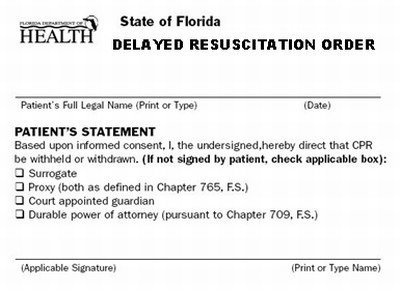
Biostasis and the Social Security Administration
When taking into account the implications of cryonics, one must consider the basic methods of personal identity and the returning of same to a person revived from biostasis. If a Social Security number for a person entering into cryonic suspension is simultaneously placed in a suspended state (and not into a death index listing or pool for subsequent recirculation), the Social Security Administration would then NOT be required to pay out the standard, spousal death benefit, currently $255.00.[4]
If a cryonicist was permitted to retain such identification, it is possible that an asset preservation trust set up on his or her behalf may not require a separately issued tax ID number. Instead, the cryonicist’s original Social Security number, with a possible (-B) designation may be assigned to the trust and the trust may continue contributing to the Social Security system (even while their spouse receives benefits), based on the rate dictated by the interest and/or investment income of the trust.
To reiterate, upon the death of a person who, under the Revised Anatomical Gift Act, has donated his or her full or partial body to a recognized cryonics facility, all of his or her identification within the Bureau of Vital Statistics may be suspended displaying a (- B) status to avoid being placed into an index or pool for subsequent recirculation. A cryonicist’s trust fund may be maintained under his or her own, but amended SS#.
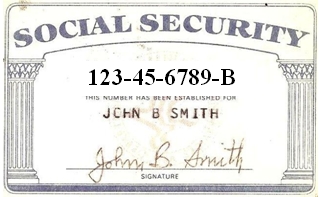
Biostasis and the Social Security Administration
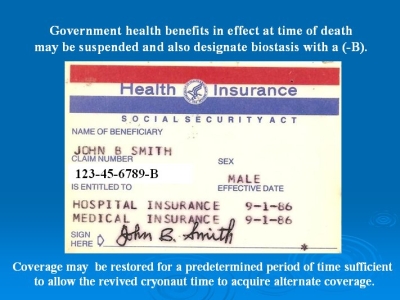
The Post-Revival Social Security Card
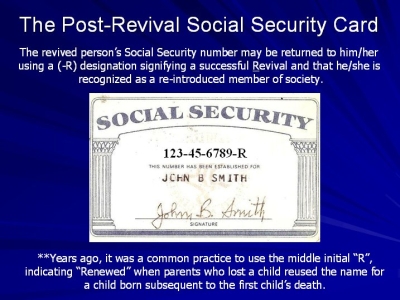
Possible Standard Certificate of Revival Form
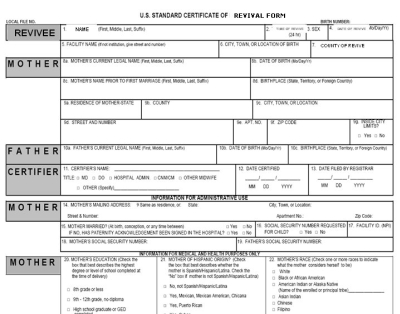
Possible Standard Certificate of Revival
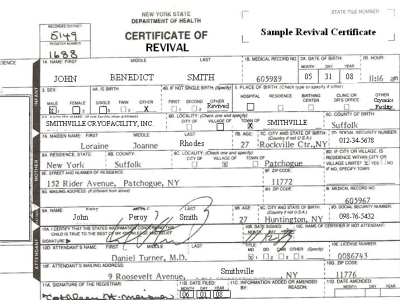
Sample of an informal Certificate of Revival
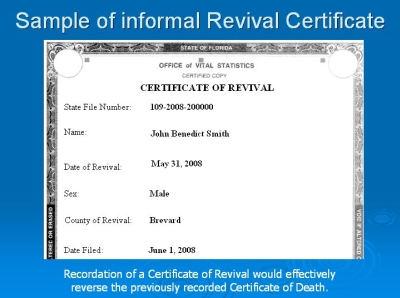
Driver’s License vs. Non-Motorist ID
Driving rules, regulations, and standards are revised periodically therefore, it is not suggested a driver’s license or driving privileges for a person revived from biostasis be automatically reinstated. It is suggested that such a privilege be sought where skills are tested as in acquiring a license or permit for the first time. Instead, for identification purposes, a non-motorist ID may be issued upon revival.
Adverse Selection & ‘Cryonicide’
The life insurance industry protects itself against claims of ‘adverse selection’ [5] with a suicide clause, preventing a person from purchasing a life insurance policy with the intent to commit suicide and thusly enrich his or her family or beneficiaries. This clause usually imposes a one to two year limitation period during which time, if an insured commits suicide, the policy is automatically null and void. In some cases, the insurance company may elect to reimburse the premiums paid by the insured to the family or beneficiary of the policy.
For each newly developed or developing technology, potentially negative uses loom in the shadows. It is possible that a person may arrange for his or her cryonic suspension with the sole intent to orchestrate a sabotage, interruption, or abrupt end to the suspension, (committing ‘cryonicide’), forestalling his or her death until such time (year) when the Economic Growth and Tax Relief Reconciliation Act (EGTRRA) of 2001 [6] dictates the Estate Tax to be most favorable to the beneficiaries or heirs of the deceased.
One manner in which an intent to commit cryonic suicide or ‘cryonicide’ may be thwarted is to employ a ‘cryonicide’ clause within a trust instrument whereby if an act of sabotage, interruption, or abrupt end to a suspension is investigated and deemed (within a court of law) that the cryonicist orchestrated his or her own death or irreversible cessation of life, then the calculation of his or her Taxable Estate, based on the last state of domicile, shall be calculated upon the rate for the year he or she entered into biostasis.
A ‘cryonicide’ orchestrated or planned by the cryonicist would then be considered a criminal act and adjudicated in the same manner as an assisted suicide, with the person(s) who assisted in the termination of the cryo-preservation be deemed to have committed a murder in the first degree.
‘Cryonicide’: Crime & Punishment
Criminal Offense and Suggested Penalties
If the interruption of a cryonic suspension results in a cryo-preserved body being deemed non-suitable for revival is found to be a criminal act, it is suggested to be considered punishable to the fullest extent of the laws pertaining to homicide or ‘cryonicide’. For example, if a criminally interrupted suspension occurs within the Alcor facility, the Arizona laws pertaining to homicide and its associated punishment shall apply. AZ Statute §13-1105. First degree murder: classification states: A. A person commits first degree murder if: 1. Intending or knowing that the person’s conduct will cause death, the person causes the death [the non-viability of revival of a cryo-preserved person] of another person, including an unborn child [analogous to a preserved person yet to be revived], with premeditation or, as a result of causing the death of another person with premeditation, causes the death if an unborn child. [emphasis added]. D. First degree murder is a class 1 felony and is punishable by death or life imprisonment as provided by sections §13-751 and §13-752 of the AZ Statutes.
AZ Statute §13-751. Sentence of death or life imprisonment; aggravating or mitigating circumstances; definition states: A. If the state has filed a notice of intent to seek the death penalty and the defendant is convicted of first degree murder as defined in section 13-1105, the defendant shall be sentenced to death or imprisonment in the custody of the state department of corrections for life or natural life as determined and in accordance with the procedures provided in section 13-752.
AZ Statute § 13-752. Sentences of death, life imprisonment or natural life; sentencing proceedings; definitions states: A. If the state has filed a notice of intent to seek the death penalty and the defendant is convicted of first degree murder, the trier of fact at the sentencing proceeding shall determine whether to impose a sentence of death in accordance with the procedures provided in this section. If the trier of fact determines that the sentence of death is not appropriate, or the state has not filed a notice of intent to seek the death penalty, and the defendant is convicted of first degree murder, the court shall determine whether to impose a sentence of life or natural life.
As previously stated, life insurance companies heavily rely on the intent of the insured during the first two years of every new policy written. Criminal law also heavily relies on intent when trying a person in court. This intent, known as mens rea, is defined in Black’s Law Dictionary as: “[t]he state of mind that the prosecution, to secure a conviction, must prove that a defendant had when committing a crime, criminal intent or recklessness.”
As the law places great emphasis and consideration on the intent of a defendant, the law should also give the same full faith and credit to the victim’s intent or state of mind when electing cryo-preservation (desiring to exist again in the future). It is obvious that a cryonicist elected to be so preserved that he or she may have the opportunity to be revived when medical science and technology have sufficiently advanced. Therefore, a purposeful interruption or abrupt end to a cryo-preservation should be deemed a murder in the first degree and punishable to the fullest extent of the law of the state in which the interruption or abrupt end occurred.
Quotations
If you have just one way of thinking and something doesn’t work under this realm of thinking, your work screeches to a halt. If you employ several realms of thinking and something ceases to make sense, you may fluidly switch to another realm and continue to make progress.
~ Paraphrased from Marvin Minsky’s Dec.10, 2007 discussion of his book, The Emotion Machine (2006).
***
“The man who has the time, the discrimination, and the sagacity to collect, and comprehend the principal facts and the man who must act upon them must draw near to one another and feel that they are engaged in a common enterprise.”
~ Woodrow Wilson, Address to American Political Science Association, December 27, 1910.
***
“Tell me and I’ll forget.
Show me and I may not remember.
Involve me and I’ll understand.”
~ Native American proverb, tribe unknown
***
“Aspire to inspire before you expire.”
~ Unknown
***
* On June 24, 2008, Mr. Charles Rothwell, Director of the Division of Vital Statistics, National Center for Health Statistics in Hyattsville, Maryland was forwarded the following question (on behalf of Loraine J. Rhodes), by Patricia Potrzebowski, Ph.D. of the Commonwealth of Pennsylvania Department of Health) for consideration:
“I pose the following question to the panel: How would the panel, under the current process, address and certify biostasis and the first revivification of a cryonically preserved person to accommodate this hopefully near-future and precedent-setting occurrence?”
It was then the opinion of Dr. Potrzebowski, “Mr. Rothwell’s Division may in several years establish another evaluation panel to revise these certificates again where [this question] and similar suggestions may be considered at that time.” **
***
Disclaimer
Though I am a legal professional, I am not an attorney thus the material contained herein is to be regarded purely as research and is not to be considered or construed, in any way, as legal advice.
Footnotes
1. Deciding About CPR: Do-Not-Resuscitate (DNR) Orders. A Guide for Patients and Families, Courtesy of NYS Department of Health. http://wings.buffalo.edu/faculty/research/bioethics/dnr-p.html
2. Standard Form for the Florida Do-Not-Resuscitate Order http://www.doh.state.fl.us/DEMO/Trauma/DNRO/Form1896.pdf
4. http://www.ssa.gov/history/lumpsum.html April 5, 2008 10:05AM EST
5. Adverse selection - the tendency of people with significant potential to file claims wanting to obtain insurance coverage. For example, those with severe health problems want to buy health insurance, and people going to a dangerous place such as a war zone want to buy more life insurance. Companies employing workers in dangerous occupations want to buy more workers’ compensation coverage. In order to combat the problem of adverse selection, insurance companies try to reduce their exposure to large claims by either raising premiums or limiting the availability of coverage to such applicants. http://www.answers.com/topic/adverse-selection... May 23, 2008 1:21PM EST
6. Economic Growth and Tax Relief Reconciliation Act of 2001 - http://www.irs.gov/pub/irs-irbs/irb01-30.pdf May 23, 2008 1:32PM EST
Bio

Loraine J. Rhodes, CLA is a nationally Certified Legal Assistant applying her knowledge in medical, commercial, and military electronics to her research in technology and the law for the Space Coast Office of Terasem Movement, Inc.